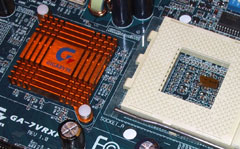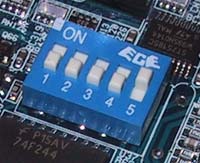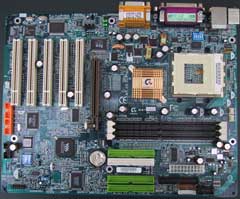VIA KT333 Motherboard Roundup - June 2002
by Anand Lal Shimpi on June 13, 2002 5:41 AM EST- Posted in
- Motherboards
Gigabyte GA-7VRXP
|
Motherboard Specifications |
|
|
CPU
Interface
|
Socket-462
|
|
Chipset
|
VIA
KT333 North Bridge
VIA VT8233A South Bridge |
|
Bus
Speeds
|
100
- 200MHz (in 1MHz increments)
|
|
Core
Voltages Supported
|
+5%
+7.5% +10% |
|
AGP
Voltages Supported
|
1.50V
- 1.80V
|
|
DRAM
Voltages Supported
|
2.50V
- 2.80V
|
|
Memory
Slots
|
3
184-pin DDR DIMM Slots
|
|
Expansion
Slots
|
1
AGP Slot
5 PCI Slots |
|
Onboard
RAID
|
Promise
PDC20276
|
|
Onboard
USB 2.0/IEEE-1394
|
VIA
VT6202 (4 USB 2.0 ports)
|
|
Onboard
LAN
|
Realtek
TRL8100BL
|
|
Onboard
Audio
|
Creative
Labs CT5880 - 2 Channel
|
Gigabyte actually beat EPoX to the punch when it came to releasing their KT333 board; the 7VRXP was in our hands when VIA announced the chipset back in February; and unlike the EPoX board, Gigabyte actually implemented VIA's USB 2.0 controller on the board.

The 7VRXP has five PCI slots an AGP 4X slot along with three DIMM slots. Unfortunately, the board is only stable with two banks populated at DDR333 speeds. The North Bridge has a very small heatsink on it and a thermistor protrudes from the center of the CPU socket; the Athlon XP's on-die thermal diode goes unused on the Gigabyte 7VRXP.
The 7VRXP uses a Realtek 10/100 Ethernet adapter as well as a Creative Labs CT5880 DSP and a Sigmatel AC'97 codec. We've never been huge fans of the CT5880 as it just drives up the cost of the motherboard without bringing many features to the table, but it gives Gigabyte the ability to market their board as having on-board Creative Labs audio. The lack of any 6-channel audio support is a bit disappointing considering that most manufacturers have moved to 6-channel solutions from CMedia or Avance Logic.
The Promise IDE RAID controller is also a disappointment since it uses the same BIOS as the other boards equipped with Promise RAID chips. This limits RAID 0 arrays to a single stripe size of 64KB, which is unfortunately too low for most applications to get the biggest benefit from a RAID 0 array.

The 7VRXP is the only board in the roundup to feature a dual BIOS solution where a backup of the BIOS is stored on a physically separate chip. This feature is useful in the event of a problem flashing the primary BIOS that would normally render the system unusable; improperly flashed BIOSes are also common causes of RMAs which Gigabyte's solution helps to reduce.

Dip-Switch for Multiplier Adjustment
Our biggest complaint about the board is that Gigabyte has once again resorted to a BIOS setup without clock multiplier adjustments. They had done this in the past, but they finally started including it in some of their boards but once again it's been pulled out of the BIOS and is only available through dipswitches on the motherboard. Having the support is better than nothing, but it takes very little effort to offer the functionality in the BIOS like most other manufacturers. We hope that their next generation boards will offer this functionality.

Multiplier settings on the board, not in the BIOS
With only two DIMMs installed, we had no stability issues with the 7VRXP during our testing.











0 Comments
View All Comments